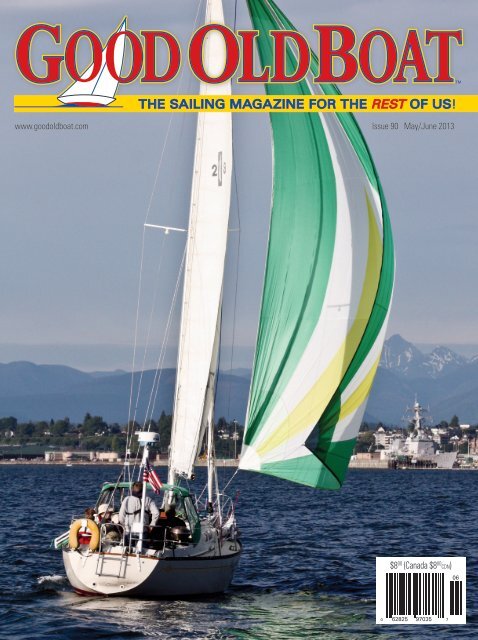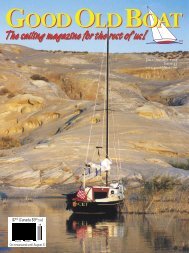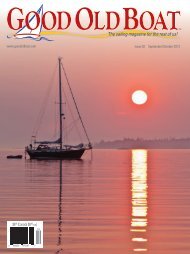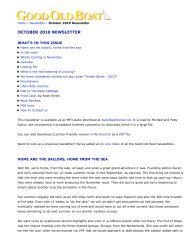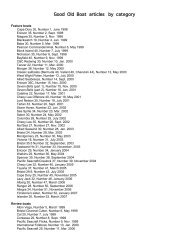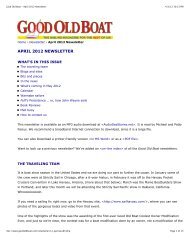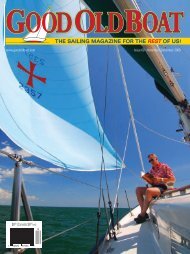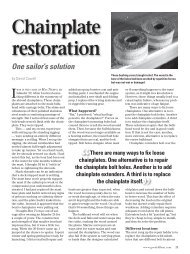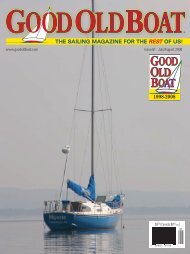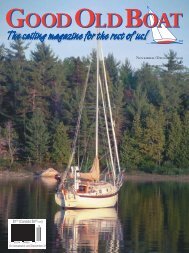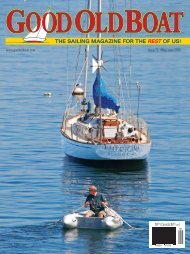promotional PDF - Good Old Boat Magazine
promotional PDF - Good Old Boat Magazine
promotional PDF - Good Old Boat Magazine
Create successful ePaper yourself
Turn your PDF publications into a flip-book with our unique Google optimized e-Paper software.
TM<br />
www.goodoldboat.com Issue 90 May/June 2013<br />
$8 00 (Canada $8 00 CDN)<br />
06<br />
0 62825 97035 7
10<br />
Speaking seriously<br />
Sailboats 101<br />
14 The Cunningham 101<br />
A simple way to power up or down the mainsail<br />
by Don Launer<br />
Voice of experience<br />
20 Fire aboard<br />
Prevention demands diligence and vigilance<br />
by Ed Zacko<br />
Making your own<br />
32 Louvers made easy<br />
Interior ventilation as an art form<br />
by Dan Cripe<br />
Interior improvements<br />
42 Maximizing stowage<br />
Creative solutions for hard-to-use spaces<br />
by Petrea McCarthy<br />
Electronic wizardry<br />
44 Weather in pictures<br />
Satellite radio delivers data and images to the cockpit<br />
by Durkee Richards<br />
Rigging matters<br />
56 Mast-raising magic<br />
Persistence pays off with a solo solution<br />
by Rob Mazza<br />
Contents<br />
May/June 2013<br />
For the love of sailboats<br />
Review boat<br />
10 C&C 34+<br />
A fast racer/cruiser from the early ‘90s<br />
by Richard Smith<br />
50 MacGregor 26X<br />
A versatile trailerable that’s as divisive<br />
as it is popular<br />
by Allen Penticoff<br />
Refit boat<br />
16 Sundew returns to bloom<br />
Years of tender care revived a wilting Watkins<br />
by Jim Shroeger<br />
Spotlight on . . .<br />
Maintenance tasks<br />
34 A multi-tasking seacock<br />
Adding a tee adds versatility<br />
by Paul Esterle<br />
36 A mast boot for all seasons<br />
Rubber roofing out of a can does the trick<br />
by David Lynn<br />
39 Replacing rudder bearings<br />
Simple original construction<br />
means a simple repair<br />
by Jim Craighead<br />
36<br />
www.audioseastories.com May/June 2013 <strong>Good</strong> <strong>Old</strong> <strong>Boat</strong> 1
Contents may/june 2013<br />
What’s more<br />
Web sightings<br />
5 Signature cove stripes, back issues, and<br />
downloadable current issues<br />
The view from here<br />
7 The design spiral<br />
<strong>Boat</strong> evolution is a non-linear process<br />
by Karen Larson<br />
60<br />
26<br />
Mail buoy<br />
8 <strong>Boat</strong> rescuing, catboats with gaff rigs,<br />
and staying young<br />
Cruising memories<br />
26 Salvaging a dream<br />
When super-human effort isn’t enough, humanity succeeds<br />
by Philip DiNuovo and Leslie Linkkila<br />
Simple solutions<br />
58 Poor man’s vacuum bag<br />
Applying the principle without the cost<br />
by Ben Zartman<br />
Quick and easy<br />
60 Shrouds in hosiery<br />
<strong>Old</strong> socks for laid-up standing rigging<br />
by Marilyn Kinsey<br />
61 Hatch covers<br />
They block out heat, light, and prying eyes<br />
by Gregg Nestor<br />
64 <strong>Good</strong> old classifieds<br />
72 Product launchings<br />
Portable, stowable shade and laser rescue flare<br />
Reflections<br />
73 The last voyage<br />
One more challenge before letting go<br />
by Michael Hoffman<br />
61<br />
About the cover . . .<br />
Michael Holtzinger’s 1976<br />
Islander 28, Anastasis<br />
(Greek for resurrection), is<br />
this issue’s cover charmer.<br />
The Everett Naval Base<br />
and Washington’s Cascade<br />
Mountains complete<br />
the scene. Brian Banker<br />
took this photo from his<br />
1979 Newport 28.<br />
www.audioseastories.com May/June 2013 <strong>Good</strong> <strong>Old</strong> <strong>Boat</strong> 3
Rigging matters<br />
Mast-raising magic<br />
Persistence pays off with a solo solution<br />
by Rob Mazza<br />
Almost every boat manufacturer eventually tries its<br />
hand at designing a mast-raising system, with varying<br />
degrees of success. While I was with C&C, I was project<br />
manager on the Mega 30 and, while with Hunter, I headed the<br />
design team under Warren Luhrs that produced the Hunter 23.5<br />
and 26 water-ballasted trailerables. All three of these boats were<br />
built with self-contained mast-raising systems.<br />
The goal of every deck-stepped mast-raising operation is<br />
that it be self-contained, safe, and easily operated by a small<br />
number of people.<br />
These operations always involve two components. One<br />
is the mechanism for raising and lowering the mast and the<br />
other is a system for stabilizing the mast to prevent it from<br />
oscillating from side to side during the process.<br />
As it’s being raised or lowered, the mast rotates around<br />
a pin in the mast step or tabernacle. Leverage is provided<br />
by a gin pole or by an A-frame pivoting at the deck at a<br />
point in line with the mast step or chainplates. Either of<br />
these systems is operated by a block and tackle (often the<br />
mainsheet tackle) attached at the bow or a line led forward<br />
around a block at the stemhead and aft to a cockpit winch.<br />
The connection from the gin pole or A-frame to the masthead<br />
is inevitably the jib halyard.<br />
Because the pivot point at the mast step is almost always<br />
higher than the chainplate pins — due either to the crown of<br />
the deck or the mast being stepped on a deckhouse top — the<br />
shrouds themselves cannot be used to provide the required<br />
transverse support unless the chainplate pins are raised to be<br />
perfectly in line with, and on the same axis as, the mast-heel<br />
pivot pin. Some boat owners have actually added stainlesssteel<br />
chainplate structures to achieve this, but the most<br />
common solution is to mount lifeline stanchions in line with<br />
the mast-heel pivot pin and weld eyes to those stanchions in<br />
line with the pivot-pin axis. To these eyes are attached the<br />
bottom ends of transverse support wires led to attachment<br />
points on the lower section of the spar at a height easily<br />
reached from deck once the mast is raised so that it can be<br />
disconnected and removed.<br />
When visiting my old friend Danny Klacko at Klacko Spars<br />
in Oakville, Ontario, recently, I was intrigued when he said,<br />
“While you’re here, I want to show you something on my<br />
C&C 27. I’ve been working on mast-raising systems for more<br />
than 40 years, and I think I’ve finally developed the absolute<br />
best solution for any existing boat with a deck-stepped mast<br />
of virtually any size.”<br />
Resources<br />
Danny Klacko will quote on systems for non-DIY boat owners:<br />
klackospars@bellnet.ca<br />
www.klackospars.com<br />
Two A-frames share common pivot points at the deck and are<br />
connected by a wire between their apexes. The forward one provides<br />
the raising lever and the after one lateral support for the mast.<br />
The pivot point of the A-frames is not level with that of the mast, but the<br />
apex of the after A-frame, attached to the spinnaker-pole car, accommodates<br />
the offset by rising up the mast as the mast is being raised.<br />
When the mast reaches its fully vertical position, it remains supported<br />
by the A-frame while the shrouds are connected to the chainplates.<br />
56 <strong>Good</strong> <strong>Old</strong> <strong>Boat</strong> May/June 2013 www.goodoldboat.com
The apex of the after A-frame attaches to the ring on the spinnakerpole<br />
car with a snapshackle. The stainless-steel wire leading forward<br />
connects it to the forward A-frame.<br />
The key to this system<br />
is the use of a spinnaker-pole track<br />
with a freely moving car.<br />
His boat was sitting behind the shop on her trailer with<br />
the mast lowered. At the word from Danny, the young man<br />
on board started cranking on the cockpit winch and the mast<br />
rose from the horizontal to the vertical in less than a minute.<br />
At a nod from Danny, the line on the winch was eased, and<br />
the mast reversed its trajectory. At all times the mast was<br />
completely under control with no evidence of sideways<br />
oscillation as it went through its arc.<br />
After the mast has been lowered and the after A-frame disconnected<br />
from the mast, both frames can be rotated forward so they can be<br />
stowed on deck or removed. Once disconnected from the deck, the<br />
A-frames “scissor” together for ease of storage.<br />
A custom-made stainless-steel tabernacle allows the mast to pivot<br />
and also serves as the mast step.<br />
The deck pivot is designed to allow the A-frames to stow one on top<br />
of the other when folded down. The toggle connections allow freedom<br />
of movement. The bracket is bolted to the toerail so it can be easily<br />
removed when not needed.<br />
Articulating A-frames<br />
The unique feature of the Klacko system is the use of two<br />
connected A-frames mounted on common deckplates port and<br />
starboard, with the apex of the aft pair attached to the car on<br />
the spinnaker-pole track with a snapshackle.<br />
The aft A-frame supports the spar laterally, independently<br />
of the shrouds. The apex of the forward A-frame is connected<br />
to the apex of the aft frame with a stainless-steel wire. The<br />
lifting force is applied with a line led through a block on the<br />
stemhead and directly aft to a cockpit winch. When the mast<br />
is down, the aft frame is almost horizontal and the forward<br />
frame is vertical. As the mast is raised, the frames rotate as<br />
well, with the forward frame becoming horizontal and the aft<br />
frame vertical when the mast is up.<br />
Once the mast has been raised and the forestay hooked<br />
up, the the aft A-frame can be quickly disconnected from the<br />
spinnaker pole car and the A-frames folded for storage.<br />
The key to this system is the use of a spinnaker-pole track<br />
with a freely moving car. Since the mast and the aft A-frame<br />
rotate around different pivot points, the car must be able to<br />
move along the track as the mast rotates about its pivot. For<br />
sailors who don’t have a spinnaker-pole track and don’t want<br />
to install one, a bridle around the mast or even a 12-inch-long<br />
link plate between the apex of the A-frame and the fixed<br />
point on the mast would work, but neither system offers the<br />
same amount of transverse fixity that the spinnaker-pole<br />
track and car provide. Mounting a short length of track and a<br />
car, even if the boat is not equipped with a spinnaker, is still<br />
the best solution.<br />
Danny Klacko, after 40 years of development, freely shares<br />
this concept with anyone who would like to copy it.<br />
Rob Mazzais a <strong>Good</strong> <strong>Old</strong> <strong>Boat</strong> contributing editor. A sailor<br />
by passion and yacht designer by vocation, his long career<br />
around sailboats began at C&C Yachts back when now good<br />
old C&Cs were cutting-edge new.<br />
www.audioseastories.com May/June 2013 <strong>Good</strong> <strong>Old</strong> <strong>Boat</strong> 57


